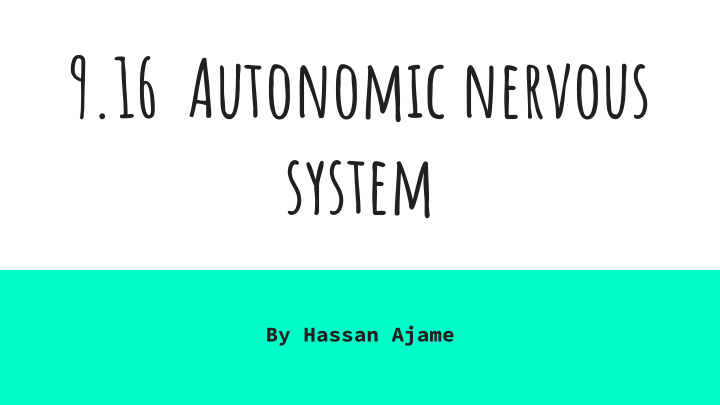



9.16 Autonomic nervous system By Hassan Ajame
Objectives.. Content objective: students will show understanding of the autonomic nervous system, its characteristics and contents. Language objective: students will demonstrate their understanding of the section through answering questions about the autonomic nervous system at the end of the presentation.
The autonomic nervous system (ANS) Part the (PNS) in which it functions continuously but ● unconsciously and autonomously. Main purpose is to regulate the functions of certain ● internal organs such as: Heart rate ○ Bloodpressure ○ Breathing rate ○ Body temperature ○ The system also regulates the actions of smooth muscles, ● cardiac muscles and certain glands to control their visceral functions.
Sympathetic and parasympathetic divisions The (ANS) includes 2 divisions, sympathetic and ● parasympathetic divisions. Sympathetic division: prepares the body for threatening, stressful and emergency situations and is responsible for the “fight or flight” response. Parasympathetic division: works by counterbalancing the effects of the sympathetic division and tries to bring back the body into a resting state after it goes through the sympathetic division by decreasing its effects.
Sympathetic and parasympathetic divisions cont. Sympathetic division : It's preganglionic fibers appear in the gray matter of ● spinal cord. When sympathetic division occurs, axons move from the ● spinal cord and through ventral roots of the spinal nerves to the thoracic and lumbar segments. The axons then leave the spinal nerves into a chain of ● sympathetic ganglia and within it synapses with second neurons and then return to the spinal nerves.
Sympathetic and parasympathetic divisions cont. Parasympathetic division: Originating from the brainstem region of the ● spinal cord, preganglionic fibers lead their way into the cranial and sacral nerves to the ganglia in the viscera. From there the postganglionic fibers travel ● from the ganglia and straight into muscles and glands.
Autonomic nerve fibers The ANS consists of 2 motor neurons ● The cell body of one neuron is located in the spinal cord ● and brain and the second extends to a visceral effector. The Preganglionic fiber is the axon within the cell body ● that is located in the brain and spinal cord in which it travels through the CNS and synapse with the neurons within an autonomic ganglion. The Postganglionic fiber is the axon within the second ● cell body that run from the ganglion to the effector organ.
Autonomic neurotransmitters Preganglionic fibers can also be called cholinergic ● fibers because they secrete acetylcholine. Postganglionic fibers secrete norepinephrine and are ● therefore called adrenergic fibers . These postganglionic neurotransmitters cause the effects ● of the sympathetic and parasympathetic divisions leading to the effector organs.
Control of autonomic activity The autonomic nervous system is mainly controlled by the ● brain and spinal cord. Medulla oblongata: receives sensory impulses from the viscera on vagus nerve fibers to stimulate motor responses in muscles and glands through the use of autonomic nerve pathways. Hypothalamus: regulates body temperature, hunger, thirst, and electrolyte balance through autonomic pathways similarly to the medulla. Limbic system/cerebral cortex: controls and regulates emotional activity or stress also through autonomic pathways.
Quiz.. 1. What are the 2 divisions in the autonomic nervous system? 2. What are the 2 types of autonomic nerve fibers? 3. The sympathetic division prepares the body for stressful and emergency situations. True or False?
Recommend
More recommend